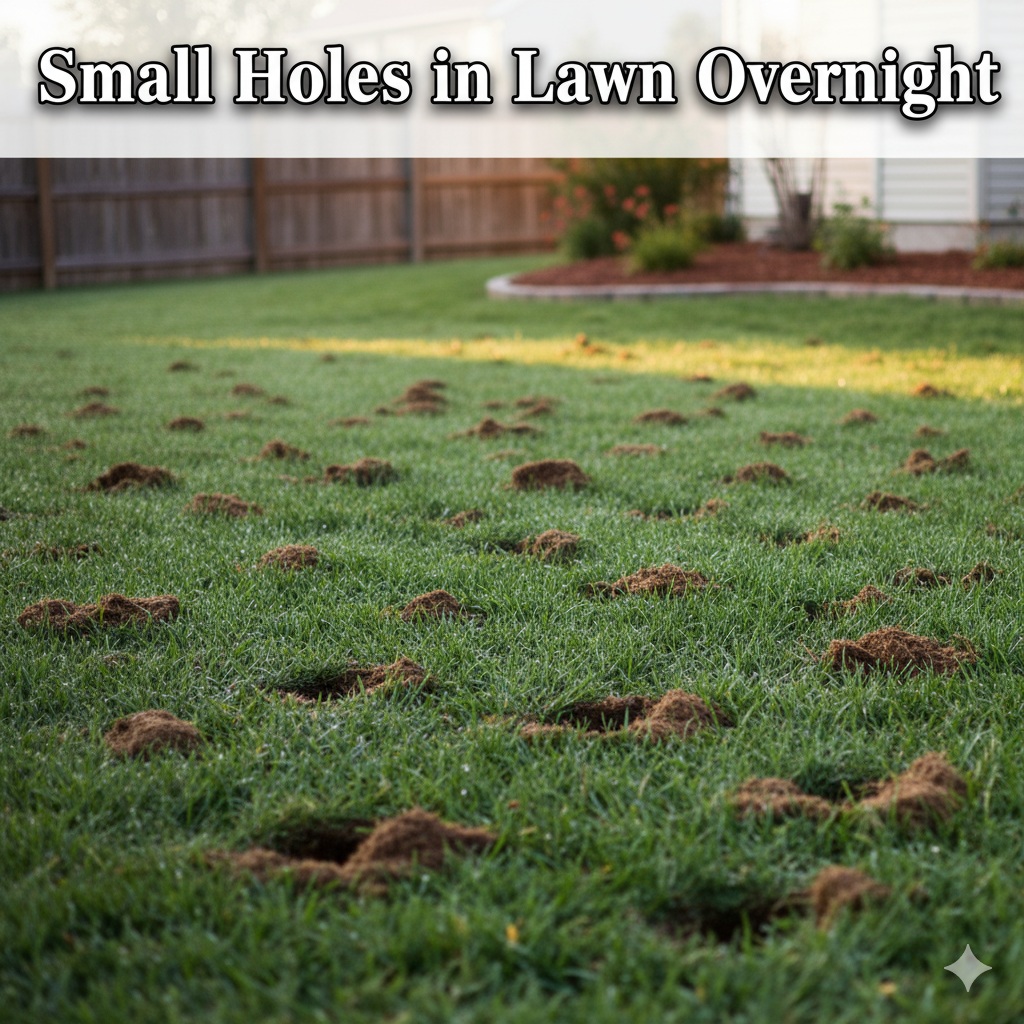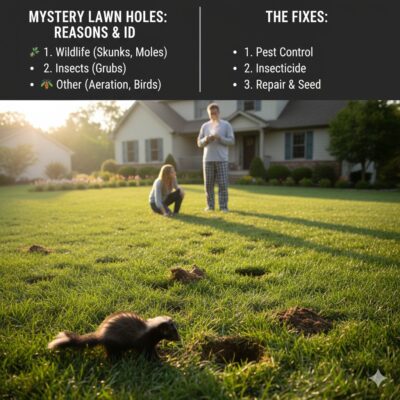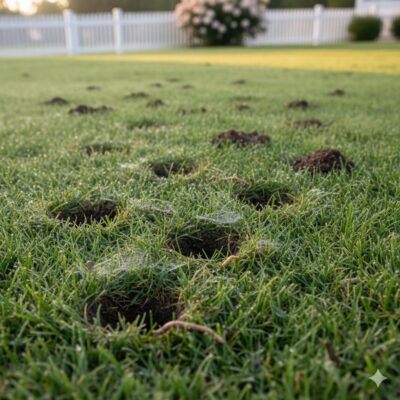
You wake up in the morning, grab your coffee, step outside to admire your lawn — and notice small holes scattered overnight. No mounds. No trails. Just mysterious little craters dotting your otherwise perfect turf.
So what caused them? The culprits could be animals, insects, environmental factors, or even drainage issues. Identifying the type and shape of the hole is the key to solving the mystery.
This complete guide explains the possible causes, types of holes, identifying signs, and proven fixes for small holes in your yard or garden.
🌱 1. Common Causes of Small Holes in Your Lawn
There are several reasons small holes appear in lawns, and most can be traced to wildlife or insect activity. Let’s look at the most common causes.
1.1 Nocturnal Animal Activity
If holes appear overnight, animals are your most likely suspects. Many creatures dig for food, nesting, or protection after dusk.
Common nighttime diggers include:
- Skunks
- Raccoons
- Armadillos
- Opossums
- Moles
- Voles
These animals dig primarily in search of grubs, worms, and soil insects. If your lawn has a grub infestation, it’s an open buffet for these diggers.
1.2 Birds and Insects
During early morning hours, birds like crows, starlings, and robins often peck small round holes while hunting for larvae.
Likewise, insects like wasps, beetles, and ground bees create small entry points to underground nests.
1.3 Earthworms and Natural Aeration
Not all holes are bad! Earthworms create small, pencil-sized holes that aerate the soil naturally. These tiny tunnels improve lawn health by increasing oxygen and nutrient movement.
1.4 Poor Drainage or Water Runoff
Excessive rain or improper grading can cause erosion holes in low-lying areas. Water drains through soft soil, leaving behind small sinkholes or depressions.
1.5 Pets and Domestic Animals
Dogs often dig out of curiosity, boredom, or to bury toys. Cats sometimes scratch at soil to mark territory. If holes are irregular and near fences or corners, pets could be responsible.
🐾 2. Animals and Likely Culprits Causing Small Holes in Your Lawn
Identifying the animal that made the holes helps in applying the right fix. Below is a detailed breakdown by animal type, hole appearance, and habits.

2.1 Skunks
Hole Size: 1–3 inches wide, shallow cone-shaped pits
When Active: Nighttime
Signs: Strong odor, scattered turf patches
Reason: Searching for grubs, worms, or larvae
Fix:
- Apply a grub control treatment (imidacloprid or nematodes).
- Remove pet food and trash that attract skunks.
- Use motion-activated sprinklers or lights at night.
2.2 Raccoons
Hole Size: 2–4 inches wide, irregular patches
When Active: Late night
Signs: Torn sod, paw prints, scattered turf
Reason: Feeding on insects and grubs
Fix:
- Roll back sod and treat for grubs.
- Secure garbage cans.
- Install yard fencing or motion lighting.
2.3 Armadillos
Hole Size: 1–2 inches wide, 3–5 inches deep
When Active: Night
Signs: Cone-shaped holes, multiple in one area
Reason: Searching for worms, beetles, and larvae
Fix:
- Remove food sources (insects).
- Use castor oil-based repellents.
- Close off crawl spaces where they may shelter.
2.4 Moles
Hole Size: 1.5 inches, often with raised tunnels nearby
When Active: Early morning or night
Signs: Raised ridges, spongy turf
Reason: Burrowing for earthworms and grubs
Fix:
- Use mole traps or bait like Talpirid.
- Treat lawn for grubs to eliminate food source.
- Maintain short, dry turf to deter worms.
2.5 Voles
Hole Size: 1–1.5 inches wide
When Active: Day and night
Signs: Surface runways, clipped grass, near trees or garden edges
Reason: Nesting and feeding on roots
Fix:
- Remove mulch layers near foundations.
- Set snap traps near active runways.
- Use vole repellents (castor oil, predator urine).
2.6 Ground Bees (Digger Bees)
Hole Size: ¼–½ inch wide
When Active: Spring to early summer
Signs: Small holes surrounded by fine soil
Reason: Females digging nests for eggs
Fix:
- Water lawn deeply to make soil less attractive.
- Avoid pesticides—bees are pollinators.
- They usually leave after nesting season.
2.7 Earthworms
Hole Size: Pencil-width
When Active: Year-round
Signs: Small piles of granular soil (worm castings)
Reason: Natural soil aeration
Fix:
- No action needed. Earthworm holes benefit your lawn.
2.8 Birds
Hole Size: Small punctures, less than ½ inch
When Active: Early morning
Signs: Peck marks, feathers nearby
Reason: Searching for grubs and insects
Fix:
- Reduce grub population.
- Use reflective bird deterrent tape or decoy owls.
🌾 3. Types and Shapes of Holes in Your Yard
Different animals and causes create distinct hole patterns and shapes. Here’s how to read them:
| Hole Type | Shape | Depth | Possible Culprit |
|---|---|---|---|
| Small round hole, 1 inch | Circular | 2–3 in | Mice, voles |
| Cone-shaped hole, 2 inch | Tapered | 4–5 in | Skunks, armadillos |
| Irregular torn patch | Uneven | 1–2 in | Raccoons |
| Tiny pencil hole | Circular | Shallow | Earthworms |
| Hole with mound of soil | Circular | 2–4 in | Moles, gophers |
| Hole with no mound | Clean edge | 1–3 in | Birds, insects, voles |
🌿 4. Specific Hole Types Explained
4.1 Holes in Yard with No Mounds
If you see holes without dirt mounds, it means the animal entered or exited the hole cleanly — likely insects, birds, or voles rather than burrowing rodents.
Likely Causes:
- Ground bees (¼-inch)
- Voles (1–2 inches)
- Birds pecking for grubs
Fix:
Treat for insects and avoid overwatering your lawn.
4.2 2-Inch Holes in Lawn
Holes around 2 inches wide are typically from skunks, chipmunks, or armadillos.
Identifying Signs:
- Cone-shaped, deep holes = Armadillos
- Flat circular holes with dirt tossed out = Chipmunks
Fix:
- Repel or trap chipmunks humanely.
- Apply grub control to reduce digging motivation.
4.3 1-Inch Holes in Yard
Small 1-inch holes are generally made by insects, voles, or small birds.
They are shallow, and often clustered in soft soil or garden edges.
Fix:
- Monitor if holes increase overnight.
- If near plants, check for vole tunnels under roots.
- Fill holes with soil and treat area with repellents.
4.4 Small Round Holes in Garden
These are typically signs of insect or small rodent activity.
If found near vegetable roots or mulch, field mice or cutworms might be present.
Fix:
- Remove mulch and debris.
- Use ultrasonic pest repellers.
- Set humane traps if rodents confirmed.
🧩 5. How to Identify Holes in My Yard
When you spot mysterious holes, use this quick diagnostic checklist:
✅ Step 1: Measure Hole Diameter
Use a ruler to check size — ¼ inch, 1 inch, or 2 inches can tell a lot about the culprit.
✅ Step 2: Check for Mounds or Soil Piles
Mounds = burrowing animals (moles, gophers).
No mound = surface diggers or insects.
✅ Step 3: Observe Time of Appearance
Appeared overnight = nocturnal animals (raccoons, skunks).
Appeared during day = birds, squirrels, or insects.
✅ Step 4: Look for Additional Signs
- Tracks or droppings
- Torn turf
- Plant root damage
- Odors (skunks)
✅ Step 5: Use a Trail Camera (Optional)
Set up a motion camera overnight to identify animal activity.

🧠 6. How to Fix and Prevent Small Holes in Your Lawn
Once you’ve identified the cause, follow these proven methods to repair and prevent holes.
Step 1: Address Food Sources
Most animals dig for insects, grubs, or worms.
Apply grub control treatments like Milky Spore or beneficial nematodes in early spring.
Step 2: Fill and Reseed
- Fill holes with a mix of topsoil and sand.
- Reseed using grass type matching your lawn (fescue, Bermuda, etc.).
- Water lightly to encourage regrowth.
Step 3: Use Natural Repellents
- Castor oil works for moles, voles, and armadillos.
- Cayenne pepper or garlic spray can deter raccoons and skunks.
- Motion-activated lights or sprinklers discourage nocturnal visitors.
Step 4: Repair Drainage Issues
Fix low spots that collect water, as they attract insects and animals.
Step 5: Maintain Lawn Health
Healthy turf resists damage better.
- Aerate annually
- Fertilize properly
- Mow regularly
- Remove excess thatch
❓ FAQs About Small Holes in Lawn
Q1: Why do holes appear in my lawn overnight?
A: Nocturnal animals like skunks, raccoons, and armadillos dig for grubs and insects, often leaving small holes by morning.
Q2: What causes small holes with no dirt around them?
A: Usually birds, insects, or voles — they don’t push soil up while digging.
Q3: Are small holes harmful to my lawn?
A: Some, like earthworm holes, help aerate soil. But holes from pests or drainage issues can damage grass and roots over time.
Q4: How can I tell if it’s moles or voles?
A: Moles leave raised tunnels and mounds; voles create clean entry holes with visible surface runways.
Q5: Can I prevent holes naturally without chemicals?
A: Yes! Use motion deterrents, natural repellents, and encourage predators like owls or snakes to control rodent populations.
Q6: How long does it take to repair lawn holes?
A: Minor holes heal within 2–3 weeks after filling and reseeding, provided proper watering and fertilization.
🌼 Final Thoughts
Small holes in your lawn may look mysterious, but every hole tells a story — from skunks on a midnight hunt to bees nesting underground.
The key is observation: note the size, shape, and timing to pinpoint the true cause.
Once you identify the culprit, you can fix, fill, and prevent damage efficiently — restoring your green lawn to perfection.
A healthy, pest-free yard starts with balanced soil, pest management, and consistent lawn care — because even the smallest holes can reveal the biggest problems if ignored.

I’m David man behind Lawn Mowerly; I’ve been dealing with lawnmowers and Tractors with my father since I was a kid. I know every make and model and what each one is capable of and love helping people find the perfect equipment for their needs.
